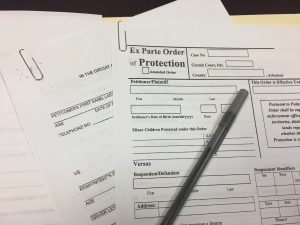 What is an Order of Protection?
What is an Order of Protection?
An Order of Protection is a civil court order, signed by a judge to protect a victim from domestic violence. The order of protection is designed to prevent an abuser from harassing, threatening, stalking or engaging in acts of violence against their victim. The Order can only be dismissed by the judge issuing the Protection Order.
There are two types of protection orders: temporary and permanent.
A temporary order of protection is also known as an ex parte order of protection. This is an emergency order to provide you and/or your family with immediate protection from your abuser. A temporary order of protection shall be effective for a fixed period not to exceed 30 days. A hearing shall be set for no later than 30 days from the issuance of the temporary order. A permanent order offers the same protection as a temporary order only it lasts longer. The permanent order can only be issued after a full court hearing and can last anywhere from 90 days to 10 years.
Who Can Get an Order of Protection?
- Spouse or Former Spouse
- Parents and Children
- People related by blood within fourth degree of consanguinity
- People currently living together or in the past lived together
- Any adult family or household member on behalf of a minor that is residing in the household
- People who have or have had a child in common
- People in a dating relationship or have been in a past dating relationship with each other
- In-Laws (persons related by marriage within the second degree of consanguinity)
What County Can I File In?
- The county where you live (this includes temporarily staying in a domestic violence shelter)
- The county where the abuse occurred
- The county where the abuser lives
What are the Steps for Getting an Order of Protection?
- Complete a petition for an order of protection and affidavit. Some circuit clerk’s offices have a court/victim advocate to help guide you through the process. There has to be a recent threat of physical harm, actual harm or physical harm.
- You will need: Identification and an address where the person can be served. It can be home, work or relative’s house, if there.
- The clerk’s office will submit the petition to the judge for review. The judge will read the petition and determine whether or not to grant a temporary order of protection.
- If the judge believes you are in immediate danger you will be granted an Ex Parte (temporary order of protection). The temporary order will go into effect as soon as the abuser is served.
- The judge will schedule a court hearing within the next 30 days to determine if you should be granted a permanent order of protection. If the judge does not feel you are entitled to a temporary order of protection, he/she will still give you a date for a court hearing which will take place within the next 30 days.
- Once the paperwork is received back from the judge at the clerk’s office, a copy will be made available to you, the petitioner, for your records and a copy will be delivered to the local sheriff’s office so the abuser can be served
- It is very important for you to attend the hearing. The hearing provides an opportunity for you and your abuser to tell your side of the story and present evidence to the judge. The temporary order expires on the date of your hearing. If you cannot attend court, you must contact the circuit clerk’s office immediately.
What Can the Order Do?
- Keep the abuser away from your home, job, church, school or any other address where you frequently go and want protection.
- Make your abuser move out of the house if you are living together.
- Stop the abuser from contacting you
- Orders the abuser to stop harming or harassing you
Source: Arkansas Legal Services Partnership (www.arlegalservices.org), WomensLaw.org-Arkansas Statutes



